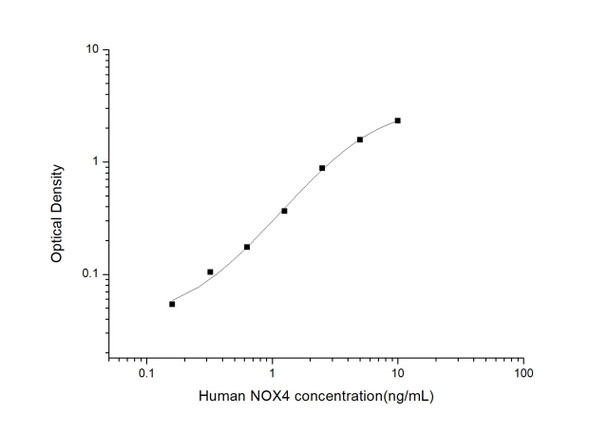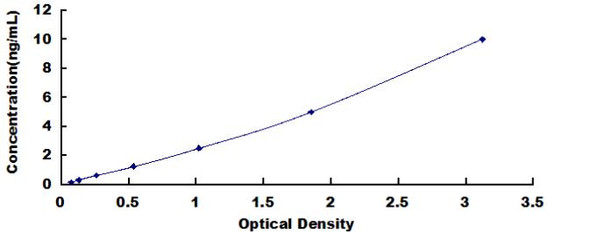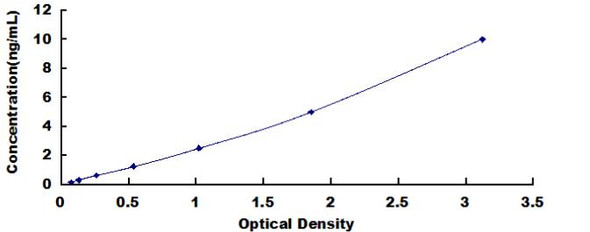Human Cell Biology ELISA Kits 1
Human NOX4 (Nicotinamide Adenine Dinucleotide Phosphate Oxidase 4) ELISA Kit (HUES03114)
- SKU:
- HUES03114
- Product Type:
- ELISA Kit
- Size:
- 96 Assays
- Uniprot:
- Q9NPH5
- Sensitivity:
- 0.09ng/mL
- Range:
- 0.16-10ng/mL
- ELISA Type:
- Sandwich
- Synonyms:
- KOX, KOX-1, RENOX, NADPH Oxidase 4
- Reactivity:
- Human
- Sample Type:
- Serum, plasma and other biological fluids
- Research Area:
- Cell Biology
Description
| Assay type: | Sandwich |
| Format: | 96T |
| Assay time: | 4.5h |
| Reactivity: | Human |
| Detection Method: | Colormetric |
| Detection Range: | 0.16-10 ng/mL |
| Sensitivity: | 0.10 ng/mL |
| Sample Volume Required Per Well: | 100µL |
| Sample Type: | Serum, plasma and other biological fluids |
| Specificity: | This kit recognizes Human NOX4 in samples. No significant cross-reactivity or interference between Human NOX4 and analogues was observed. |
This ELISA kit uses Sandwich-ELISA as the method. The micro ELISA plate provided in this kit has been pre-coated with an antibody specific to Human NOX4. Standards or samples are added to the appropriate micro ELISA plate wells and combined with the specific antibody. Then a biotinylated detection antibody specific for Human NOX4 and Avidin-Horseradish Peroxidase (HRP) conjugate are added to each micro plate well successively and incubated. Free components are washed away. The substrate solution is added to each well. Only those wells that contain Human NOX4, biotinylated detection antibody and Avidin-HRP conjugate will appear blue in color. The enzyme-substrate reaction is terminated by adding Stop Solution and the color turns yellow. The optical density (OD) is measured spectrophotometrically at a wavelength of 450 nm ± 2 nm. The OD value is proportional to the concentration of Human NOX4. The concentration of Human NOX4 in samples can be calculated by comparing the OD of the samples to the standard curve.
| UniProt Protein Function: | NOX4: Constitutive NADPH oxidase which generates superoxide intracellularly upon formation of a complex with CYBA/p22phox. Regulates signaling cascades probably through phosphatases inhibition. May function as an oxygen sensor regulating the KCNK3/TASK-1 potassium channel and HIF1A activity. May regulate insulin signaling cascade. May play a role in apoptosis, bone resorption and lipolysaccharide-mediated activation of NFKB. May produce superoxide in the nucleus and play a role in regulating gene expression upon cell stimulation. Isoform 3 is not functional. Isoform 4 displays an increased activity. Isoform 5 and isoform 6 display reduced activity. 7 isoforms of the human protein are produced by alternative splicing. |
| UniProt Protein Details: | Protein type:Membrane protein, integral; EC 1. 6. 3. -; Membrane protein, multi-pass; Cell cycle regulation; Nucleolus; Oxidoreductase Chromosomal Location of Human Ortholog: 11q14. 2-q21 Cellular Component: endoplasmic reticulum membrane; focal adhesion; mitochondrion; perinuclear region of cytoplasm; apical plasma membrane; nucleolus; integral to membrane; stress fiber; NADPH oxidase complex Molecular Function:oxygen sensor activity; electron carrier activity; FAD binding; NAD(P)H oxidase activity; superoxide-generating NADPH oxidase activity; nucleotide binding; heme binding Biological Process: positive regulation of apoptosis; cell morphogenesis; cell aging; homocysteine metabolic process; positive regulation of smooth muscle cell migration; cardiac muscle cell differentiation; positive regulation of MAP kinase activity; negative regulation of cell proliferation; positive regulation of protein kinase B signaling cascade; positive regulation of stress fiber formation; response to hypoxia; inflammatory response; superoxide release; bone resorption |
| NCBI Summary: | This gene encodes a member of the NOX-family of enzymes that functions as the catalytic subunit the NADPH oxidase complex. The encoded protein is localized to non-phagocytic cells where it acts as an oxygen sensor and catalyzes the reduction of molecular oxygen to various reactive oxygen species (ROS). The ROS generated by this protein have been implicated in numerous biological functions including signal transduction, cell differentiation and tumor cell growth. A pseudogene has been identified on the other arm of chromosome 11. Alternative splicing results in multiple transcript variants. [provided by RefSeq, Jan 2009] |
| UniProt Code: | Q9NPH5 |
| NCBI GenInfo Identifier: | 212276447 |
| NCBI Gene ID: | 50507 |
| NCBI Accession: | Q9NPH5. 2 |
| UniProt Secondary Accession: | Q9NPH5,Q5K3R4, Q5K3R5, Q5K3R6, Q5K3R8, Q7Z7G3, Q86V92 A8K715, B7Z520, E7EMD7, |
| UniProt Related Accession: | Q9NPH5 |
| Molecular Weight: | Calculated MW: 6kDa/25-31kDa/58-66kDaObserved MW: 67 kDa |
| NCBI Full Name: | NADPH oxidase 4 |
| NCBI Synonym Full Names: | NADPH oxidase 4 |
| NCBI Official Symbol: | NOX4 |
| NCBI Official Synonym Symbols: | KOX; KOX-1; RENOX |
| NCBI Protein Information: | NADPH oxidase 4; kidney oxidase-1; renal NAD(P)H-oxidase; kidney superoxide-producing NADPH oxidase |
| UniProt Protein Name: | NADPH oxidase 4 |
| UniProt Synonym Protein Names: | Kidney oxidase-1; KOX-1; Kidney superoxide-producing NADPH oxidase; Renal NAD(P)H-oxidase |
| Protein Family: | NADPH oxidase |
| UniProt Gene Name: | NOX4 |
| UniProt Entry Name: | NOX4_HUMAN |
As the OD values of the standard curve may vary according to the conditions of the actual assay performance (e. g. operator, pipetting technique, washing technique or temperature effects), the operator should establish a standard curve for each test. Typical standard curve and data is provided below for reference only.
| Concentration (ng/mL) | O.D | Average | Corrected |
| 10 | 2.401 2.407 | 2.404 | 2.331 |
| 5 | 1.654 1.654 | 1.654 | 1.581 |
| 2.5 | 0.954 0.95 | 0.952 | 0.879 |
| 1.25 | 0.434 0.444 | 0.439 | 0.366 |
| 0.63 | 0.258 0.236 | 0.247 | 0.174 |
| 0.32 | 0.186 0.17 | 0.178 | 0.105 |
| 0.16 | 0.127 0.127 | 0.127 | 0.054 |
| 0 | 0.067 0.079 | 0.073 | -- |
Precision
Intra-assay Precision (Precision within an assay): 3 samples with low, mid range and high level Human NOX4 were tested 20 times on one plate, respectively.
Inter-assay Precision (Precision between assays): 3 samples with low, mid range and high level Human NOX4 were tested on 3 different plates, 20 replicates in each plate.
| Intra-assay Precision | Inter-assay Precision | |||||
| Sample | 1 | 2 | 3 | 1 | 2 | 3 |
| n | 20 | 20 | 20 | 20 | 20 | 20 |
| Mean (ng/mL) | 0.48 | 1.47 | 4.12 | 0.50 | 1.56 | 3.96 |
| Standard deviation | 0.03 | 0.07 | 0.20 | 0.03 | 0.07 | 0.21 |
| C V (%) | 6.25 | 4.76 | 4.85 | 6.00 | 4.49 | 5.30 |
Recovery
The recovery of Human NOX4 spiked at three different levels in samples throughout the range of the assay was evaluated in various matrices.
| Sample Type | Range (%) | Average Recovery (%) |
| Serum (n=5) | 89-102 | 94 |
| EDTA plasma (n=5) | 91-103 | 98 |
| Cell culture media (n=5) | 92-107 | 98 |
Linearity
Samples were spiked with high concentrations of Human NOX4 and diluted with Reference Standard & Sample Diluent to produce samples with values within the range of the assay.
| Serum (n=5) | EDTA plasma (n=5) | Cell culture media (n=5) | ||
| 1:2 | Range (%) | 91-103 | 87-100 | 93-108 |
| Average (%) | 98 | 93 | 99 | |
| 1:4 | Range (%) | 88-102 | 86-97 | 84-95 |
| Average (%) | 93 | 92 | 90 | |
| 1:8 | Range (%) | 93-104 | 82-97 | 83-95 |
| Average (%) | 99 | 88 | 90 | |
| 1:16 | Range (%) | 87-99 | 85-100 | 88-101 |
| Average (%) | 94 | 92 | 94 |
An unopened kit can be stored at 4°C for 1 month. If the kit is not used within 1 month, store the items separately according to the following conditions once the kit is received.
| Item | Specifications | Storage |
| Micro ELISA Plate(Dismountable) | 8 wells ×12 strips | -20°C, 6 months |
| Reference Standard | 2 vials | |
| Concentrated Biotinylated Detection Ab (100×) | 1 vial, 120 µL | |
| Concentrated HRP Conjugate (100×) | 1 vial, 120 µL | -20°C(shading light), 6 months |
| Reference Standard & Sample Diluent | 1 vial, 20 mL | 4°C, 6 months |
| Biotinylated Detection Ab Diluent | 1 vial, 14 mL | |
| HRP Conjugate Diluent | 1 vial, 14 mL | |
| Concentrated Wash Buffer (25×) | 1 vial, 30 mL | |
| Substrate Reagent | 1 vial, 10 mL | 4°C(shading light) |
| Stop Solution | 1 vial, 10 mL | 4°C |
| Plate Sealer | 5 pieces | |
| Product Description | 1 copy | |
| Certificate of Analysis | 1 copy |
- Set standard, test sample and control (zero) wells on the pre-coated plate and record theirpositions. It is recommended to measure each standard and sample in duplicate. Note: addall solutions to the bottom of the plate wells while avoiding contact with the well walls. Ensuresolutions do not foam when adding to the wells.
- Aliquot 100µl of standard solutions into the standard wells.
- Add 100µl of Sample / Standard dilution buffer into the control (zero) well.
- Add 100µl of properly diluted sample (serum, plasma, tissue homogenates and otherbiological fluids) into test sample wells.
- Cover the plate with the sealer provided in the kit and incubate for 90 min at 37°C.
- Aspirate the liquid from each well, do not wash. Immediately add 100µL of BiotinylatedDetection Ab working solution to each well. Cover the plate with a plate seal and gently mix. Incubate for 1 hour at 37°C.
- Aspirate or decant the solution from the plate and add 350µL of wash buffer to each welland incubate for 1-2 minutes at room temperature. Aspirate the solution from each well andclap the plate on absorbent filter paper to dry. Repeat this process 3 times. Note: a microplatewasher can be used in this step and other wash steps.
- Add 100µL of HRP Conjugate working solution to each well. Cover with a plate seal andincubate for 30 min at 37°C.
- Aspirate or decant the solution from each well. Repeat the wash process for five times asconducted in step 7.
- Add 90µL of Substrate Reagent to each well. Cover with a new plate seal and incubate forapproximately 15 min at 37°C. Protect the plate from light. Note: the reaction time can beshortened or extended according to the actual color change, but not by more than 30min.
- Add 50 µL of Stop Solution to each well. Note: Adding the stop solution should be done inthe same order as the substrate solution.
- Determine the optical density (OD value) of each well immediately with a microplate readerset at 450 nm.






